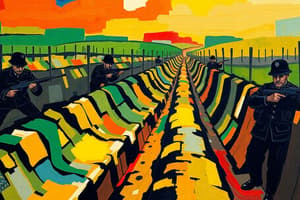Podcast
Questions and Answers
Define Trench Warfare.
Define Trench Warfare.
Was a form of military conflict in which opposing sides fought one another from trenches facing one another.
Explain 'War of Movement.'
Explain 'War of Movement.'
War of movement consisted of a pattern of 'action' and 'reaction' where both sides advanced at the same time.
Briefly describe 'War of Attrition.'
Briefly describe 'War of Attrition.'
A war of attrition was based around which side can survive the longest and which side would give in.
Define 'Stalemate.'
Define 'Stalemate.'
What was the 'Front Line'?
What was the 'Front Line'?
Why were trenches dug in a 'zig-zag' pattern?
Why were trenches dug in a 'zig-zag' pattern?
Briefly describe the purpose of communication trenches.
Briefly describe the purpose of communication trenches.
What was the support line, and what purpose did it serve?
What was the support line, and what purpose did it serve?
What was the purpose of having 'Duckboards' in the trenches?
What was the purpose of having 'Duckboards' in the trenches?
What was the purpose of barbed wire?
What was the purpose of barbed wire?
What were dugouts used for?
What were dugouts used for?
What was the 'Sandbags' filled with, and where were they situated?
What was the 'Sandbags' filled with, and where were they situated?
What was Parapet?
What was Parapet?
Briefly describe 'No Man's Land.'
Briefly describe 'No Man's Land.'
Why were German trenches generally built better than French and British trenches?
Why were German trenches generally built better than French and British trenches?
What was the 'Ammunition Shelf' used for?
What was the 'Ammunition Shelf' used for?
What was a 'Fire Step' and what was it used for?
What was a 'Fire Step' and what was it used for?
What did 'BEF' stand for?
What did 'BEF' stand for?
When and why did 'BEF' come to France's aid?
When and why did 'BEF' come to France's aid?
Outline the main motives of the Schlieffen Plan.
Outline the main motives of the Schlieffen Plan.
Who took over the Schlieffen Plan, and how did it differ from the original plan?
Who took over the Schlieffen Plan, and how did it differ from the original plan?
Who created Plan 17 and what were the main aims of it?
Who created Plan 17 and what were the main aims of it?
What was a main reason for the emergence of the stalemate?
What was a main reason for the emergence of the stalemate?
Who were the Allies?
Who were the Allies?
What was significant about the battle at Liege?
What was significant about the battle at Liege?
Where was the Western Front situated?
Where was the Western Front situated?
Flashcards are hidden until you start studying
Study Notes
Trench Warfare Overview
- Trench warfare involved armies fighting from opposing trenches, leading to a stalemate and prolonged conflict.
- "War of movement" alternated between advances and retreats, contrasting with stagnant trench scenarios.
- "War of attrition" focused on lasting endurance, where one side aimed to outlast the other.
Key Terminology
- Stalemate: A deadlock preventing progress by either side.
- Front line: Where the initial attacks and defenses occurred, marking direct engagement zones.
Trench Construction and Design
- Trenches followed a zig-zag pattern to limit damage from artillery explosions, confining blasts to small sections.
- Communication trenches facilitated the safe transfer of supplies to soldiers without exposure to enemy fire.
- The support line served as a fallback position for troops under bombardment.
Trench Safety Features
- Duckboards provided dry footing within trenches, helping to prevent trench foot.
- Barbed wire was used extensively as a defensive measure against enemy assaults.
- Dugouts offered rest areas and refuge during attacks, built into trench structures.
Protective Structures
- Sandbags, filled with earth, were placed atop trenches to shield soldiers from enemy fire.
- Parapet: A protective wall made of earth or wood on the trench's outer edge, offering cover for defenders.
Battlefield Geography
- No Man's Land: The contested area between opposing trenches, typically ranging from 100 to 300 meters in width.
- German trenches were more robustly constructed due to a perspective of long-term warfare, unlike British and French trenches.
Ammunition and Combat Efficiency
- Ammunition shelf: Designated storage area for weapons and ammunition within the trench.
- Fire Step: Elevated step in trenches allowing soldiers to rise above trench walls for attacking.
Strategic Forces and Plans
- British Expeditionary Force (BEF): Launched to support France during Germany's advance on Paris in 1914.
- The Schlieffen Plan aimed to swiftly encircle Paris while maintaining a strong right wing but was poorly executed after General Moltke's leadership changes led to weakening strategies.
- French Plan 17 sought to quickly reclaim Alsace and Lorraine and penetrate German territory.
Warfare Consequences
- The Schlieffen Plan's failure significantly contributed to the stalemate on the Western Front.
- The Allies consisted of France, Britain, and Russia collaborating against the Central Powers.
- The battle of Liege was crucial for delaying German progression, consuming resources needed for future engagements.
Western Front
- The Western Front stretched from the English Channel to Switzerland, becoming a core battleground of World War I.
- Shell holes, resulting from artillery attacks, became common landmarks due to the intense fighting and bombardments.
Studying That Suits You
Use AI to generate personalized quizzes and flashcards to suit your learning preferences.




